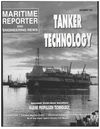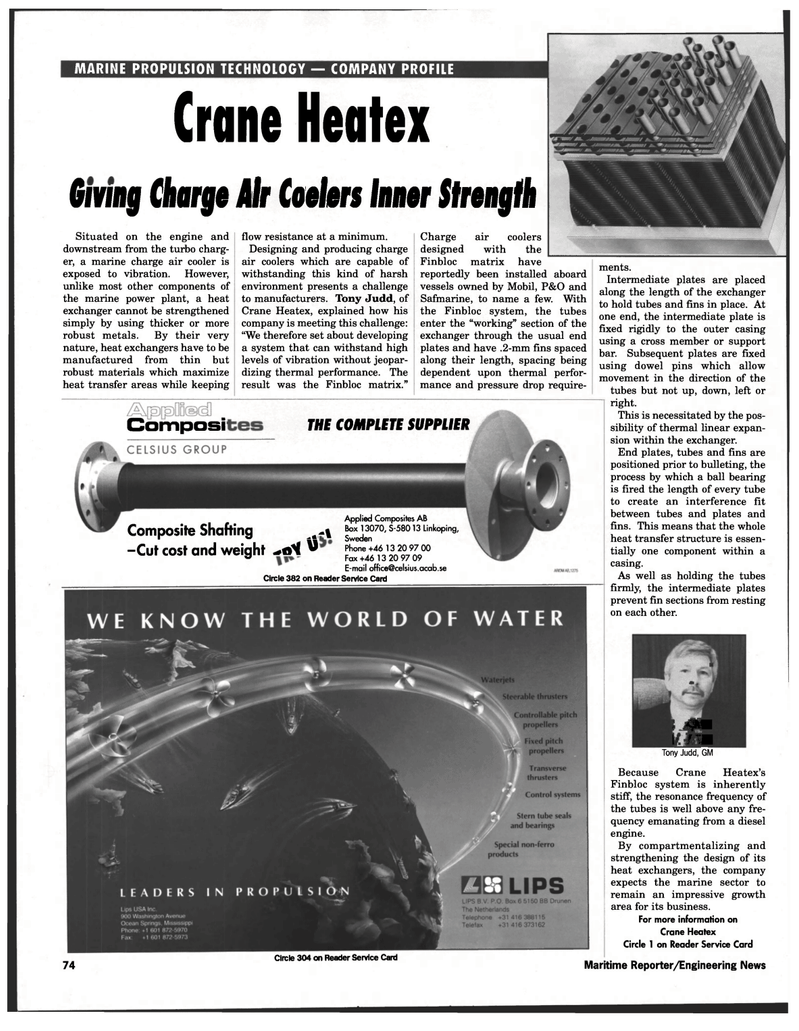
Page 74: of Maritime Reporter Magazine (September 1997)
Read this page in Pdf, Flash or Html5 edition of September 1997 Maritime Reporter Magazine
MARINE PROPULSION TECHNOLOGY — COMPANY PROFILE
Crane Heatex
Smug (hup Air (otitis law Slrtnglh
Situated on the engine and downstream from the turbo charg- er, a marine charge air cooler is exposed to vibration. However, unlike most other components of the marine power plant, a heat exchanger cannot be strengthened simply by using thicker or more robust metals. By their very nature, heat exchangers have to be manufactured from thin but robust materials which maximize heat transfer areas while keeping flow resistance at a minimum.
Designing and producing charge air coolers which are capable of withstanding this kind of harsh environment presents a challenge to manufacturers. Tony Judd, of
Crane Heatex, explained how his company is meeting this challenge: "We therefore set about developing a system that can withstand high levels of vibration without jeopar- dizing thermal performance. The result was the Finbloc matrix."
Charge air coolers designed with the
Finbloc matrix have reportedly been installed aboard vessels owned by Mobil, P&O and
Safmarine, to name a few. With the Finbloc system, the tubes enter the "working" section of the exchanger through the usual end plates and have .2-mm fins spaced along their length, spacing being dependent upon thermal perfor- mance and pressure drop require-
Composi THE COMPLETE SUPPLIER
Composite Shafting -\ -Cut cost and weight ^
Applied Composites AB
Box 13070, S-580 13 Linkoping,
Sweden
Phone +46 13 20 97 00
Fax +46 13 20 97 09
E-mail [email protected]
Circle 382 on Reader Service Card ments.
Intermediate plates are placed along the length of the exchanger to hold tubes and fins in place. At one end, the intermediate plate is fixed rigidly to the outer casing using a cross member or support bar. Subsequent plates are fixed using dowel pins which allow movement in the direction of the tubes but not up, down, left or right.
This is necessitated by the pos- sibility of thermal linear expan- sion within the exchanger.
End plates, tubes and fins are positioned prior to bulleting, the process by which a ball bearing is fired the length of every tube to create an interference fit between tubes and plates and fins. This means that the whole heat transfer structure is essen- tially one component within a casing.
As well as holding the tubes firmly, the intermediate plates prevent fin sections from resting on each other. • ..... i JfMH ! iM 74 Circle 304 on Reader Service Card
Tony Judd, GM
Because Crane Heatex's
Finbloc system is inherently stiff, the resonance frequency of the tubes is well above any fre- quency emanating from a diesel engine.
By compartmentalizing and strengthening the design of its heat exchangers, the company expects the marine sector to remain an impressive growth area for its business.
For more information on
Crane Heatex
Circle 1 on Reader Service Card
Maritime Reporter/Engineering News

 73
73

 75
75
